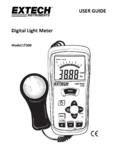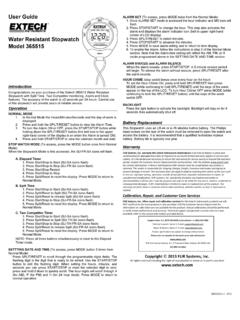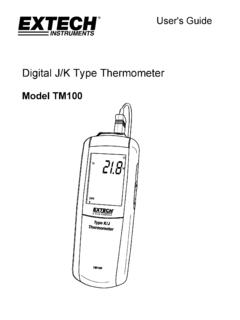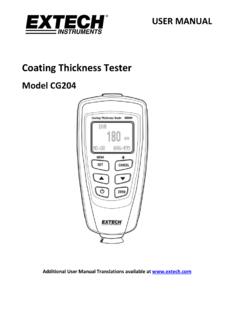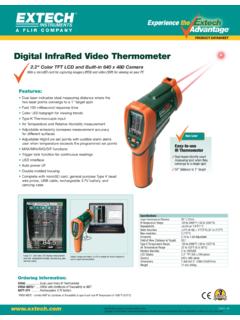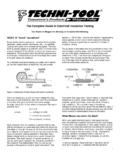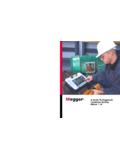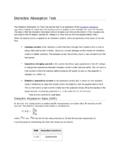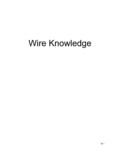Transcription of User's Guide Digital High Voltage Insulation Tester
1 User's Guide Digital high Voltage Insulation Tester Model 380395 or 380396 8/14 2 Introduction Congratulations on your purchase of the Extech 380395 (120V) or 380396 (220V) high Voltage Insulation Tester . This meter provides four Insulation Resistance test ranges plus Continuity, AC/DC Voltage , Polarization Index and Dielectric Absorption Ratio measurements. This meter is shipped fully tested and calibrated and, with proper care and use, will provide years of reliable service. Features Auto ranging 6000 count LCD display with bargraph Selectable LCD backlight level function facilitates working in dimly illuminated areas. MAX/MIN, PEAK, Relative, and Data hold functions for DC/AC Voltage measurements. Designed to the following safety standards: IEC 61010-1 (CAT IV 600V Pollution degree 2) IEC 61010-031 (Requirements for hand-held probes) Insulation test range: to 60G.
2 Insulation test voltages: 500V, 1000V, 1500V, and 5000V. AC/DC Voltage : V to 600 V. 200mA Continuity. Resistance: to 6k . Auto-discharge function & Voltage output warning function. Electric charges stored in capacitive circuits are automatically discharged after measurements. Discharge status can be checked using the real time Voltage bargraph. LIVE circuit warning symbols plus audible warning. Live circuit detection prevents Insulation test if Voltage > 30 V is detected. Auto-power off function and battery check. Programmable Test Timer measurement function. Polarization Index measurement (PI). Dielectric Absorption Ratio measurement (DAR). Power source: Eight (8) C Cell Batteries. 8/14 3 Safety International Safety Symbols This symbol, adjacent to another symbol or terminal, indicates the user must refer to the manual for further information.
3 This symbol, adjacent to a terminal, indicates that, under normal use, hazardous voltages may be present. Danger: identifies conditions and actions that pose hazard(s) to the user. Warning: alerts the user to avoid electric shock. Caution: identifies conditions and actions that may damage the Insulation Resistance Tester . Operating Caution: identifies conditions where the user needs to take extra care during the operation of the Insulation resistance Tester Danger: Use of this instrument in a manner not specified by the manufacturer may impair safety features/protection provided by the equipment. Read all of the safety information carefully before using or servicing the instrument. This symbol indicates that the meter uses double or reinforced Insulation . Safety Notes Do not exceed the maximum allowable input range for any of the meter s functions.
4 Set the function switch OFF when the meter is not in use. Remove the batteries if the meter is to be stored for longer than 60 days. Warnings Set the function switch to the appropriate position before measuring. Do not measure current on a circuit whose Voltage exceeds 600V. When changing ranges always disconnect the test leads from the circuit under test. Do not use the Insulation resistance Tester if it is damaged or if metal parts are exposed. Also, check the meter for cracks or missing plastic. Be careful when working above 30V AC rms or 30V DC. Such voltages pose a shock hazard. Discharge all circuit loads under test after measuring high Voltage . Do not replace the batteries with the Tester in a wet environment. Place the test leads in the proper input terminals.
5 Ensure that the test leads are firmly connected to the Insulation Resistance Tester s input terminals. Ensure that the Insulation Resistance Tester is switched off when opening the battery compartment. 8/14 4 Cautions Improper use of this meter can cause damage, shock, injury or death. Read and understand this user manual before operating the meter. Always remove the test leads before replacing the batteries. Inspect the condition of the test leads and the meter itself for any damage before operating the meter. Repair or replace any damage before use. Voltage checks on electrical outlets can be difficult and misleading because of the uncertainty of a definitive connection to the recessed electrical contacts. Other means should be used to ensure that the outlet terminals are not "live".
6 If the equipment is used in a manner not specified by the manufacturer, the protection provided by the equipment may be impaired. Do not use the Insulation resistance Tester near explosive gas, vapor or dust. When using the test leads, keep fingers away from the lead contacts. Keep fingers behind the test lead finger guards. Do not use the Tester if its cover or any of its parts are removed. When performing resistance tests, remove all power from the circuit under test. When servicing the Insulation Resistance Tester , use only the supplied test leads and power adaptor. Do not use the Insulation resistance Tester if the battery indicator shows a low battery. Do not use or store the meter in areas of high humidity, high temperature, potentially explosive or flammable environments, or in strong magnetic fields.
7 Soft cloth and mild detergent should be used to clean the surface of the Insulation resistance Tester when servicing. Do not use abrasives or solvents. Dry the Insulation resistance Tester before storing if it is wet. Remove the test leads and set the Range selector switch to the OFF position after use. Safety Category Information This Insulation resistance Tester complies with IEC61010 standard safety measurement requirements: pollution degree 2, over- Voltage category (CAT. IV) 600V, with double Insulation . 8/14 5 Meter Description 1. Insulation resistance Test/Lock switch 2. REL /down button 3. HOLD button 4. BATT /up button 5. MAX /MIN /STOP button 6. LCD Display 7. DC power adaptor Input 8. EARTH Input 9. V input and IR GUARD terminal 10.
8 V COM input and high Voltage shielding terminal 11. LINE: 500V to 5000V high Voltage Output 12. PI /DAR /PEAK button 13. Backlight /AUTO OFF button 14. Function Selector Switch Display Description 1. Timed Test Indicators 2. AC/DC Indicators 3. Polarization Index and Dielectric Absorption Ratio Indicators 4. Analog Bargraph 5. Auto Range Indicator 6. Low Battery Indicator 7. high Voltage Indicator 8. Auto discharge Indicator 9. Continuity Buzzer Indicator 10. PASS /FAIL Indicator 11. Live Circuit Voltage Indicator 12. Units Indicator 13. Function Indicators 8/14 6 Insulation Resistance testing CAUTIONS: Ensure that no electrical charge exists on the circuit under test. Insulated gloves should be worn while testing . Use extreme caution to avoid touching the tips of the test leads or the circuit under test when the PRESS TO TEST button is pressed; high Voltage is present.
9 Do not make measurements when the battery cover is removed. Always connect the Earth Cord (black) to the Earth terminal of the circuit under test. CAUTION: When the live circuit warning indicates >30V or the warning buzzer sounds and the display flashes, the measurement cannot be made even if the Press to Test button is pressed. DANGER Do not touch the circuit under test immediately after testing . Voltage stored in the circuit may cause electric shock. Leave the test leads connected to the circuit under test and never touch the circuit until the discharge is complete. PRESS TO TEST Knob All Insulation resistance tests are initiated with the PRESS TO TEST knob. 1. Press and HOLD the knob to perform a test. Release the knob to end the test. 2. Press and TURN the knob 90 degrees clockwise to the LOCK position to lock the meter in the continuous test mode.
10 To end a test, either rotate the knob 90 degrees counterclockwise or press the STOP button. 3. Always return the knob to the vertical position before beginning a test. Emergency Stop To stop a test at any time, press the STOP button or rotate the PRESS TO TEST knob in a counter-clockwise direction. The STOP button also clears the display and beeper after a discharge is complete. 8/14 7 Insulation Resistance Test Manual Test 1. Connect the Black Earth test lead to the Earth connector and the Red test lead to the LINE and COM connectors. 2. Set the Function Selector switch to the desired Insulation test Voltage . 3. Connect the test leads to the device under test. 4. Press and hold the PRESS TO TEST button to run the test. The buzzer will beep during the test. 5. Read the measured value on the LCD display.
